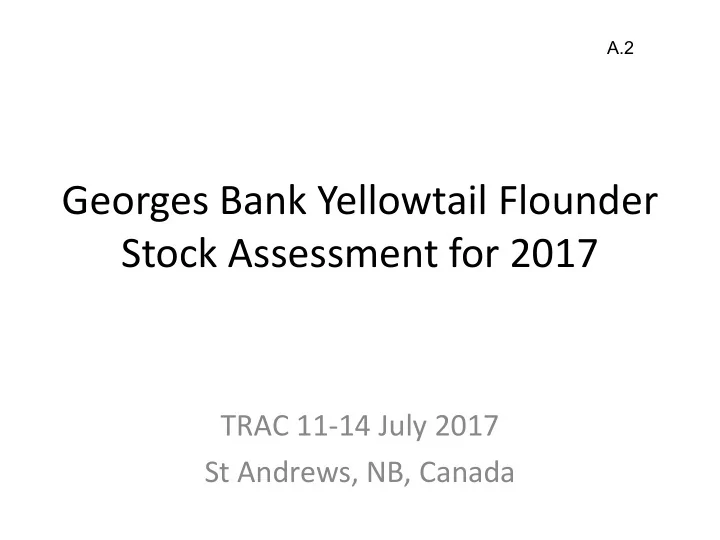

A.2 Georges Bank Yellowtail Flounder Stock Assessment for 2017 TRAC 11-14 July 2017 St Andrews, NB, Canada
TRAC Process Changes • Independent chair for meeting • Science advice from external reviewers and scientists • Broader perspective by other participants
Catch metric tons Landings Discards Catch Landings Discards Catch US 26 7 33 US 60% 16% 77% Canada 1 10 10 Canada 1% 22% 23% Sum 27 17 44 Sum 61% 39% 100% 2016 record low for both countries and total Fig 2a-b Table 1
Surveys All three surveys track well, with exception of 2008 and 2009 DFO surveys (large tow effects) Fig 6
Survey Time Series Fall 2016 3 rd lowest in 54 years Spring 2017 lowest in 50 years DFO 2017 lowest in 31 years Fig 7
Surveys at Age Low values recently at all ages No indication of incoming recruitment Does age 6+ show rebuilding? Fig 12
Relative F and Survey Z Fishing does not appear to be a major driver of stock status currently Relative F = catch / survey Survey Z Figs 14-15
2017 Intersessional on Survey q • 26 June 2017 conference call to discuss 3 WP • 2 WP estimated survey q from twin-trawl experiment • 1 WP examined herding from bridle experiment • Consensus – Use survey q = 0.31 – Use wing width for area of tow (no herding) – Apply these decisions to all three surveys • Overall effect is approx 3 fold increase in average biomass and thus catch advice for a given exploitation rate B = I * (A / a) / q
Quota split for 2018 USA 71% Empirical Approach Canada 29% Biomass (mt) mu = 0.02 0.06 Year DFO Spring Fall (year-1) Average Catch Advice (mt) 2010 29,452 68,752 83,490 60,565 1,211 3,634 2011 12,344 29,621 27,821 23,262 465 1,396 2012 18,113 46,209 30,354 31,559 631 1,894 2013 2,249 12,766 31,199 15,404 308 924 2014 1,654 8,564 10,828 7,015 140 421 2015 2,650 5,861 12,682 7,064 141 424 2016 5,569 3,610 5,811 4,997 100 300 2017 1,104 2,819 5,432 3,118 62 187 There are no indications in the data that support increasing the quota
Empirical Approach (cont.) Year Quota (mt) Catch (mt) Quota/Avg Catch/Avg Model Type 2010 1,956 1,170 3% 2% VPA 2011 2,650 1,171 11% 5% VPA 2012 1,150 725 4% 2% VPA 2013 500 218 3% 1% VPA 2014 400 159 6% 2% VPA 2015 354 118 5% 2% Empirical 2016 354 44 7% 1% Empirical 2017 300 10% Empirical mean 958 515 6% 2%
TRAC Broader Perspective Exploitation Rate Catach Advice (mt) 2% 62 4% 125 6% 187 8% 249 10% 312 12% 374 14% 437 16% 499 The broader TRAC agreed there were no indications in the data that support increasing the catch advice for 2018 from the 300 mt quota for 2017, but feel the possibility of low catch advice for yellowtail flounder limiting the catch of other species such as sea scallops and groundfish should be considered as well.
Perretti et al. Working Paper
Monte Carlo Simulation
Monte Carlo Simulation
Summary • 2016 catch lowest in time series • State of resource poor • Relative F low and survey Z high • TRAC advice 62 to 187 mt for 2018 • No basis to increase quota above 2017 value of 300 mt
Recommend
More recommend